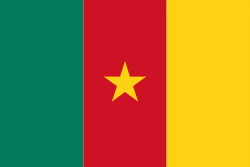Mamfe
Mamfe or Mamfé is a city in and the capital of Manyu, a division of the Southwest Region in Cameroon. It is 74 km from the border of Nigeria, on the Manyu River. It has a population of 36,500 (2017 estimate).
It is known as a centre for traditional religion (e.g., Obasinjom and Ekpe Society) and traditional medicine. Mamfe used to be known for bad infrastructure within the city limits, especially the roads, but in recent times the roads have been tarred and are currently in good condition. The roads leading in and out of the city have also been tarred e.g., Mamfe - Bamenda, Mamfe - Kumba, Mamfe - Ekok.
The Peace Corps has maintained a presence in the Mamfe area since they entered the country in 1962. Since 2017, Mamfe has been a frequent battleground in the Anglophone Crisis. The city saw heavy fighting in December 2017, when the Cameroonian Army battled the Ambazonia Defence Forces for control over Mamfe and the surroundings. In May 2020, separatist fighters assassinated the newly-elected mayor, Ashu Priestly Ojong. As of January 2023, suspected separatist fighters stormed Mamfe and set a Total petrol station on fire.
The name "Mamfe" comes from the [Bayang language]. When Germans first arrived in the area via the Cross River, the Germans greeted a local man at the Egbekaw River site who was carrying sand from the shore and tried interrogating him about where they were. The Banyang man didn't understand and only said in his dialect, "Mamfie fah?" ("Where should I put it?"). The Germans heard this as "Mamfe" and named the area so.
It is known as a centre for traditional religion (e.g., Obasinjom and Ekpe Society) and traditional medicine. Mamfe used to be known for bad infrastructure within the city limits, especially the roads, but in recent times the roads have been tarred and are currently in good condition. The roads leading in and out of the city have also been tarred e.g., Mamfe - Bamenda, Mamfe - Kumba, Mamfe - Ekok.
The Peace Corps has maintained a presence in the Mamfe area since they entered the country in 1962. Since 2017, Mamfe has been a frequent battleground in the Anglophone Crisis. The city saw heavy fighting in December 2017, when the Cameroonian Army battled the Ambazonia Defence Forces for control over Mamfe and the surroundings. In May 2020, separatist fighters assassinated the newly-elected mayor, Ashu Priestly Ojong. As of January 2023, suspected separatist fighters stormed Mamfe and set a Total petrol station on fire.
The name "Mamfe" comes from the [Bayang language]. When Germans first arrived in the area via the Cross River, the Germans greeted a local man at the Egbekaw River site who was carrying sand from the shore and tried interrogating him about where they were. The Banyang man didn't understand and only said in his dialect, "Mamfie fah?" ("Where should I put it?"). The Germans heard this as "Mamfe" and named the area so.
Map - Mamfe
Map
Country - Cameroon
 |
 |
| Flag of Cameroon | |
Early inhabitants of the territory included the Sao civilisation around Lake Chad, and the Baka hunter-gatherers in the southeastern rainforest. Portuguese explorers reached the coast in the 15th century and named the area Rio dos Camarões (Shrimp River), which became Cameroon in English. Fulani soldiers founded the Adamawa Emirate in the north in the 19th century, and various ethnic groups of the west and northwest established powerful chiefdoms and fondoms. Cameroon became a German colony in 1884 known as Kamerun. After World War I, it was divided between France and the United Kingdom as League of Nations mandates. The Union des Populations du Cameroun (UPC) political party advocated independence, but was outlawed by France in the 1950s, leading to the national liberation insurgency fought between French and UPC militant forces until early 1971. In 1960, the French-administered part of Cameroon became independent, as the Republic of Cameroun, under President Ahmadou Ahidjo. The southern part of British Cameroons federated with it in 1961 to form the Federal Republic of Cameroon. The federation was abandoned in 1972. The country was renamed the United Republic of Cameroon in 1972 and back to the Republic of Cameroon in 1984 by a presidential decree by president Paul Biya. Paul Biya, the incumbent president, has led the country since 1982 following Ahidjo's resignation; he previously held office as prime minister from 1975 on. Cameroon is governed as a Unitary Presidential Republic.
Currency / Language
| ISO | Currency | Symbol | Significant figures |
|---|---|---|---|
| XAF | Central African CFA franc | Fr | 0 |
| ISO | Language |
|---|---|
| EN | English language |
| FR | French language |















